A valuation of USD 1,052.4 million is projected for the fermented rice extracts market in 2025, and this figure is anticipated to reach USD 3,413.4 million by 2035. The overall increase of USD 2,361 million signifies more than a threefold rise in market size during the decade, translating into a CAGR of 12.5%.
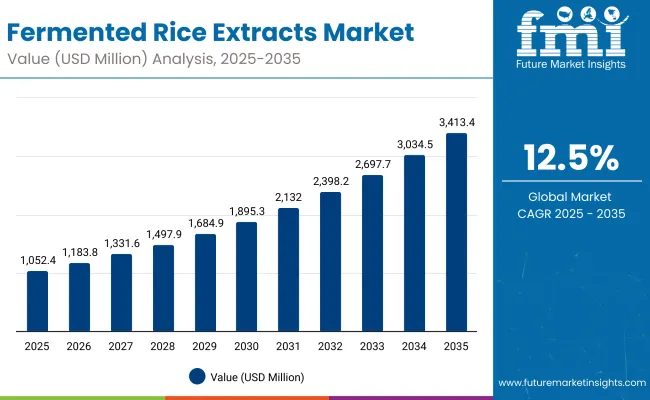
| Metric | Value |
|---|---|
| Fermented Rice Extracts Market Estimated Value in (2025E) | USD 1,052.4 million |
| Fermented Rice Extracts Market Forecast Value in (2035F) | USD 3,413.4 million |
| Forecast CAGR (2025 to 2035) | 12.50% |
The first half of the forecast period, from 2025 to 2030, is expected to record growth from USD 1,052.4 million to USD 1,895.3 million, which equals an addition of USD 842.9 million. This accounts for over one-third of total decade expansion, indicating that early momentum will be shaped by rising demand for brightening and pigmentation correction, which already contributes 54.5% of the global share.
The second phase from 2030 to 2035 is forecast to add USD 1,518.1 million, representing nearly two-thirds of total growth. The acceleration is expected to be driven by premium positioning of rice-water ferment, which currently holds 48.5% of market value, supported by sensitive-skin alignment and traditional-herbal claim credibility. Country-level dynamics will reinforce this trajectory, as China and India are forecast to expand at CAGRs of 20.5% and 23.1% respectively, making Asia a dominant growth engine. By 2035, the United States will remain significant, although its relative share is projected to contract as faster-growth regions consolidate demand. The combination of clinical efficacy in brightening, natural positioning, and digital-first retail strategies is anticipated to anchor long-term resilience, ensuring that fermented rice extracts emerge as a core segment of functional beauty actives over the decade.
From 2020 to 2024, the fermented rice extracts market steadily expanded, driven by cultural familiarity in Asia and increasing global interest in natural, heritage-based skincare actives. By 2025, value is projected at USD 1,052.4 million, with dominance held by brightening claims supported through clinical validation. Between 2025 and 2035, revenue is forecast to rise more than threefold to USD 3,413.4 million, propelled by Asia’s double-digit CAGRs, particularly India (23.1%) and China (20.5%). Competitive advantage is expected to transition from brand legacy alone toward a blend of heritage storytelling, clinical substantiation, and digital-first retail strategies. Global leaders such as SK-II are projected to defend premium positions, while regional brands leverage sensitive-skin, vegan-friendly, and fragrance-free claims to capture share. The competitive edge is forecast to shift toward authenticity, efficacy, and accessibility across digital ecosystems.
The growth of the fermented rice extracts market is being driven by multiple converging factors. Increasing consumer awareness regarding natural and safe skincare ingredients has created strong demand for botanical-based actives, with fermented rice extracts perceived as both effective and gentle. Rising adoption in brightening and pigmentation correction, which already accounts for the largest share, is expected to reinforce expansion as clinical efficacy continues to be demonstrated. Traditional-herbal claims and the clean-label narrative are gaining prominence, and this alignment with consumer preference for authenticity and sustainability is fueling wider adoption across global markets. Accelerated growth in Asia, particularly in China and India, is being supported by cultural familiarity with rice-based remedies, further amplified by modern digital retail strategies. E-commerce and specialty beauty channels are making these products highly accessible, while premium positioning and sensitive-skin compatibility are enabling higher price realization. These combined forces are ensuring that fermented rice extracts remain on a steep upward trajectory over the next decade.
The fermented rice extracts market has been segmented by function, claim, and extract type, highlighting the key attributes driving adoption across global skincare applications. Functional segmentation captures the specific benefits offered, including brightening, pigmentation correction, and other skin health enhancements that address diverse consumer concerns. Claim-based segmentation reflects the positioning strategies adopted by brands, ranging from traditional herbal narratives that emphasize heritage and authenticity, to modern claims such as natural, vegan-friendly, clean-label, and fragrance-free, which cater to contemporary lifestyle expectations. Extract type segmentation focuses on the formulation base, led by rice water ferment and other derivative forms, which together determine consumer trust, usability, and product differentiation. Each of these dimensions reveals how consumer preferences, cultural heritage, and scientific efficacy converge to define growth pathways, shaping market leadership and future opportunities for fermented rice extracts worldwide.
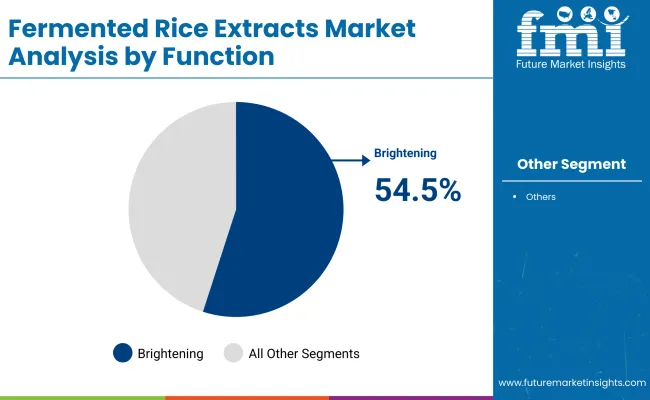
| Segment | Market Value Share, 2025 |
|---|---|
| Brightening | 54.5% |
| Others | 45.5% |
In 2025, brightening is projected to hold 54.5% share with USD 572.7 million, while other functions account for 45.5% with USD 478.36 million. This distribution highlights the continued consumer reliance on pigmentation correction as a leading skincare priority. Brightening is being reinforced by evidence-backed efficacy in tone-evening and hyperpigmentation reduction, ensuring premium acceptance across channels. Other functions such as hydration, barrier strengthening, and wrinkle reduction are collectively expanding, supported by innovation pipelines promoting multi-functional positioning. The segment’s trajectory suggests that brightening will retain dominance, while complementary functions will gradually capture greater value as diversified skin concerns are addressed. Over the next decade, multi-claim strategies are expected to strengthen the role of brightening within overall skin health formulations.
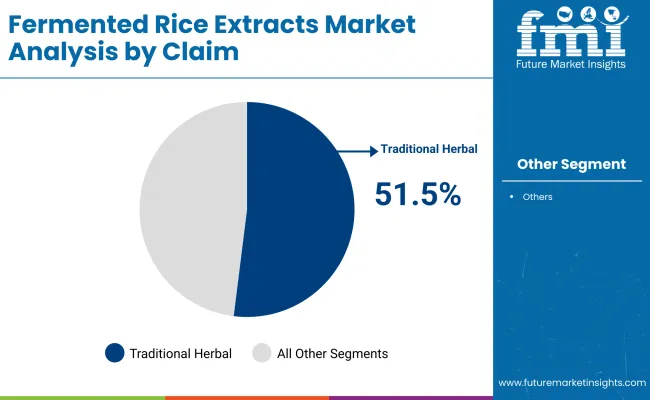
| Segment | Market Value Share, 2025 |
|---|---|
| Traditional herbal | 51.5% |
| Others | 48.5% |
In 2025, traditional herbal claims are estimated to account for 51.5% share with USD 541.4 million, while other claims represent 48.5% with USD 510.25 million. This near parity demonstrates a balance between heritage-driven narratives and modern consumer expectations for clean-label and safe ingredients. Traditional herbal positioning is expected to remain particularly strong in Asia, where rice-based remedies hold deep cultural roots. At the same time, modern claims such as vegan-friendly, fragrance-free, and natural/organic are gaining rapid traction in Western markets. This dual narrative is anticipated to expand global adoption, ensuring broader consumer reach. By 2035, while modern claims will expand significantly, traditional herbal is expected to sustain a leadership role through its trust, authenticity, and proven efficacy.
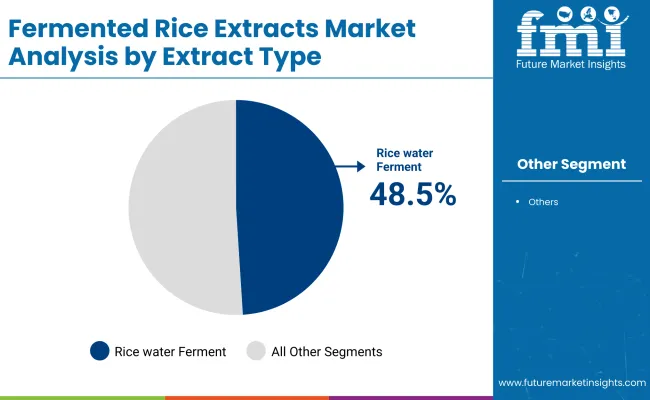
| Segment | Market Value Share, 2025 |
|---|---|
| Rice water ferment | 48.5% |
| Others | 51.5% |
In 2025, rice water ferment is projected to hold 48.5% share with USD 509.1 million, while other extract types capture 51.5% with USD 542.15 million. This distribution reflects the broad appeal of rice water ferment as a gentle, multi-functional base, complemented by specialized extracts offering differentiated performance. Rice water ferment is gaining traction for its sensitive-skin compatibility, clean-label acceptance, and established credibility across Asian beauty rituals. Other extracts are being leveraged for targeted innovation in niche applications, enabling portfolio diversification among manufacturers. Over the next decade, rice water ferment is expected to expand steadily, while the combined value of other extracts ensures complementary growth. Together, both categories create a balanced ecosystem, ensuring long-term resilience of the market.
Complex regulatory validation, evolving consumer trust, and cultural heritage alignment are shaping the fermented rice extracts market, while scalability challenges in fermentation and supply inconsistencies present barriers. Strategic innovation and targeted positioning are expected to define the industry’s long-term trajectory.
Convergence of Clinical Proof and Heritage Narratives
The market is being propelled by a unique convergence of evidence-based efficacy and culturally rooted narratives. Clinical validation of brightening outcomes, coupled with long-standing Asian heritage use, is enhancing consumer trust globally. This dual foundation is enabling premium positioning while creating a differentiated identity from generic botanical actives. As more brands invest in substantiated claim portfolios, growth momentum is expected to accelerate across both advanced and emerging markets.
Fermentation Variability and Input Dependence
Significant growth potential is tempered by the challenge of input variability. Fermentation processes are highly sensitive to rice quality, strain consistency, and environmental parameters. Any deviations compromise active potency and scalability, creating cost inefficiencies for manufacturers. Without robust supply chain frameworks and standardization protocols, sustained mass-market expansion may face constraints. Stakeholders are expected to focus increasingly on precision fermentation technologies and multi-origin rice sourcing to mitigate risks while ensuring consistent product efficacy.
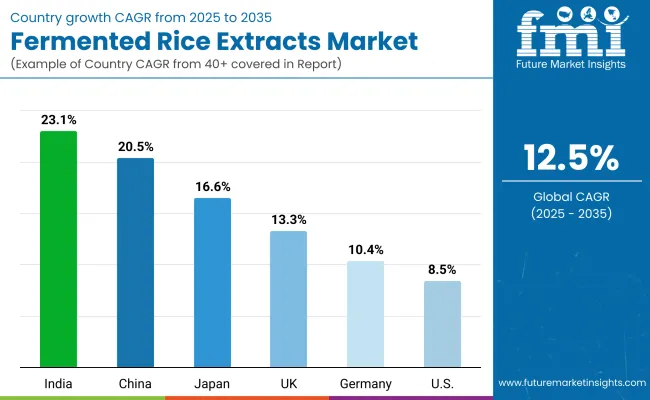
| Countries | CAGR |
|---|---|
| China | 20.5% |
| USA | 8.5% |
| India | 23.1% |
| UK | 13.3% |
| Germany | 10.4% |
| Japan | 16.6% |
The outlook for the fermented rice extracts market reveals distinct growth patterns across leading countries, shaped by cultural familiarity, consumer preference shifts, and evolving retail ecosystems. India is projected to lead expansion with a CAGR of 23.1% between 2025 and 2035, supported by strong alignment with traditional-herbal remedies and increasing adoption within modern trade and e-commerce channels. China follows closely with a CAGR of 20.5%, driven by deep cultural roots of rice-based beauty rituals and aggressive positioning of traditional herbal claims that resonate with domestic consumers. Japan is expected to record a CAGR of 16.6%, reflecting its heritage-driven beauty culture and established brand leadership in fermented skincare. Europe maintains a steady outlook, led by the UK at 13.3% CAGR and Germany at 10.4%, where clean-label and natural positioning are guiding adoption. The USA market, with a relatively modest CAGR of 8.5%, is forecast to grow steadily, propelled by rising demand for sensitive-skin formulations and dermatologist-backed claims. Together, these countries highlight a strong geographic shift, with Asia driving rapid acceleration while Europe and North America sustain growth through differentiated consumer narratives. Over the next decade, regional variations are expected to create diverse opportunities for innovation, positioning, and long-term value capture.
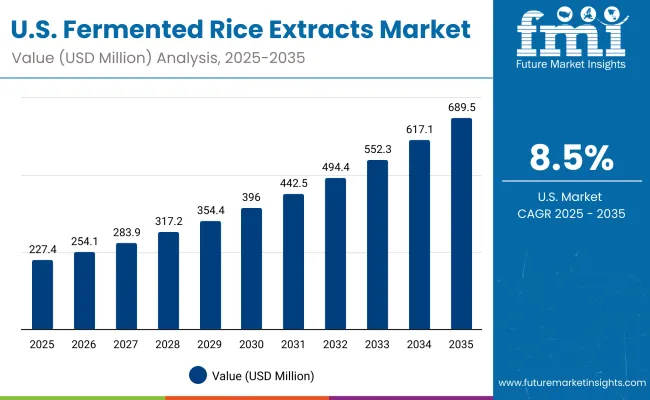
| Year | USA Fermented Rice Extracts Market (USD Million) |
|---|---|
| 2025 | 227.46 |
| 2026 | 254.14 |
| 2027 | 283.95 |
| 2028 | 317.25 |
| 2029 | 354.47 |
| 2030 | 396.04 |
| 2031 | 442.50 |
| 2032 | 494.40 |
| 2033 | 552.39 |
| 2034 | 617.18 |
| 2035 | 689.58 |
The fermented rice extracts market in the United States is forecast to expand significantly, with value expected to increase from USD 227.46 million in 2025 to USD 689.58 million by 2035. This progression reflects more than a threefold rise across the decade, underpinned by steady consumer adoption of natural, sensitive-skin compatible formulations. From 2025 to 2030, the market is projected to climb to USD 396.04 million, adding nearly USD 169 million in five years. This growth trajectory indicates rising influence of e-commerce, dermatologist-backed endorsements, and premium positioning strategies.
Between 2030 and 2035, sales are anticipated to accelerate further, adding almost USD 294 million, as mass retail and specialty formats expand product accessibility. Brightening-focused offerings, which already dominate functional preference, are expected to continue leading adoption, supported by increasing clinical substantiation. Traditional herbal claims are also forecast to resonate strongly, especially within multicultural consumer groups that value authenticity. Sensitive-skin positioning and fragrance-free claims are anticipated to reinforce long-term consumer trust.
The fermented rice extracts market in the United Kingdom is projected to grow at a CAGR of 13.3% from 2025 to 2035, supported by demand for clean-label and vegan-friendly skincare solutions. Market growth is being accelerated by consumer preference for natural alternatives, particularly in premium beauty and wellness categories. Adoption is expected to strengthen through online retail, where brand storytelling and influencer-driven endorsements continue to shape purchasing decisions. By 2035, significant value creation is anticipated through sensitive-skin formulations and fragrance-free innovations that align with regulatory expectations and consumer trust.
The fermented rice extracts market in India is forecast to expand at a CAGR of 23.1% between 2025 and 2035, making it the fastest-growing national market. Growth is being supported by strong cultural affinity for herbal remedies and rising urban demand for functional beauty solutions. Mass-market expansion through e-commerce and modern trade is expected to fuel accessibility, while premium positioning is likely to gain traction among younger consumers. Traditional-herbal claims are projected to remain central, with further reinforcement from Ayurveda-inspired formulations. By 2035, India is expected to emerge as a global growth hub, contributing significant incremental value.
The fermented rice extracts market in China is anticipated to grow at a CAGR of 20.5% during 2025-2035, driven by deep cultural resonance with rice-based beauty rituals. Strong demand is being supported by preference for traditional-herbal claims, which dominate domestic formulations. Expansion is expected to be led by digital-first retail strategies, where Chinese consumers demonstrate high responsiveness to clinical data and influencer narratives. Premium beauty retailers and specialty channels are forecast to reinforce market depth, ensuring long-term adoption. By 2035, China is projected to secure one of the highest global market shares, underpinned by rapid innovation cycles and heritage positioning.
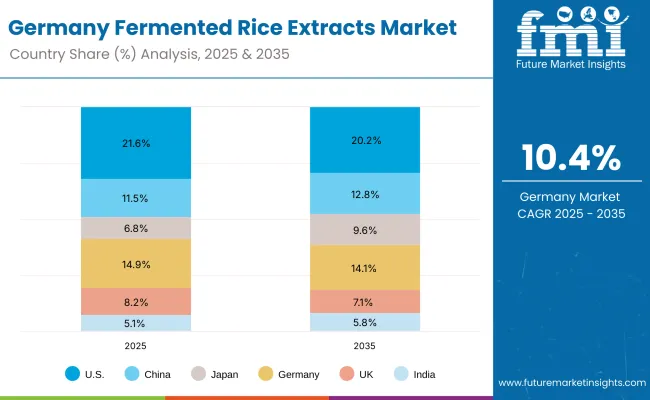
| Countries | 2025 |
|---|---|
| USA | 21.6% |
| China | 11.5% |
| Japan | 6.8% |
| Germany | 14.9% |
| UK | 8.2% |
| India | 5.1% |
| Countries | 2035 |
|---|---|
| USA | 20.2% |
| China | 12.8% |
| Japan | 9.6% |
| Germany | 14.1% |
| UK | 7.1% |
| India | 5.8% |
The fermented rice extracts market in Germany is expected to register a CAGR of 10.4% from 2025 to 2035, reflecting steady growth within Europe’s natural skincare landscape. German consumers demonstrate strong alignment with clean-label and fragrance-free claims, supporting consistent demand. Expansion is anticipated through pharmacy and specialty retail formats, where product safety and dermatological validation remain purchasing priorities. Brightening and anti-aging functions are forecast to gain momentum as clinical substantiation strengthens. By 2035, Germany is expected to consolidate its role as a key European hub for evidence-based, natural beauty solutions.
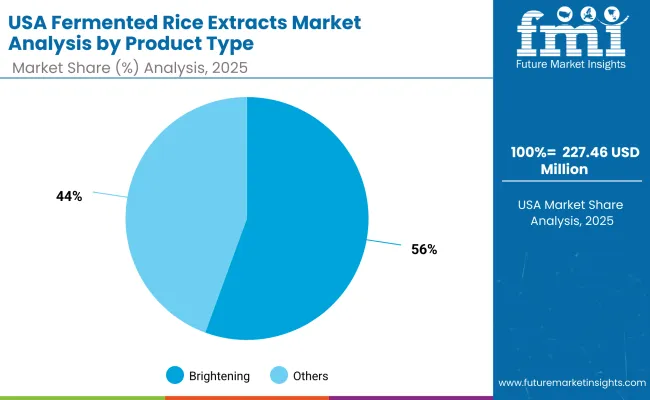
| Segment | Market Value Share, 2025 |
|---|---|
| Brightening | 55.6% |
| Others | 44.4% |
The fermented rice extracts market in the United States is projected at USD 227.46 million in 2025. Brightening functions contribute 55.6% with USD 127 million, while other functions hold 44.4% with USD 100.89 million. This functional dominance underscores the central role of pigmentation correction in consumer adoption, supported by dermatologist-backed endorsements and clinical validation. The strong preference for brightening reflects both aesthetic priorities and consumer trust in efficacy-driven outcomes. Other functions, including hydration, elasticity, and anti-aging, are gaining traction as multi-functional products expand across premium retail channels. By 2035, it is expected that brightening will remain the anchor category, though broader function diversification will capture incremental share. Innovations that integrate barrier protection and wrinkle reduction alongside brightening are anticipated to define competitive advantage.
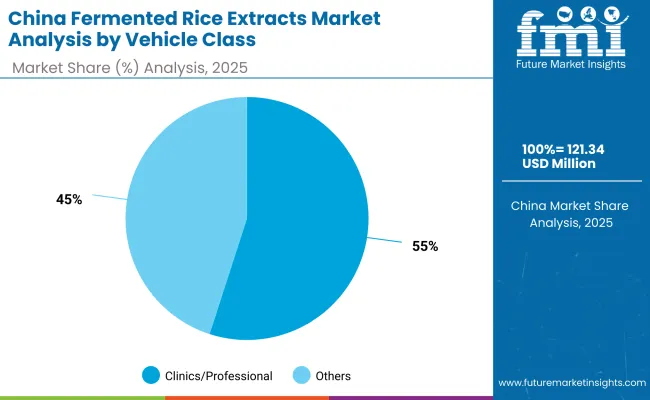
| Segment | Market Value Share, 2025 |
|---|---|
| Traditional herbal | 53.4% |
| Others | 46.6% |
The fermented rice extracts market in China is projected at USD 121.34 million in 2025. Traditional-herbal claims contribute 53.4% with USD 65 million, while other claims hold 46.6% with USD 56.52 million. This leadership of herbal claims reflects deep cultural alignment with heritage-driven remedies and consumer reliance on authenticity in beauty formulations. The narrative of traditional-herbal efficacy is being reinforced by centuries-old practices, which are now combined with scientific substantiation, ensuring long-term consumer trust. Other claims, including clean-label, vegan-friendly, and sensitive-skin positioning, are expanding, especially among younger urban consumers exposed to global beauty trends. By 2035, the traditional-herbal segment is expected to retain its anchor role, though modern claims are anticipated to accelerate adoption in mass and premium channels. The interplay between heritage credibility and modern innovation is projected to define China’s competitive landscape in fermented rice extracts.
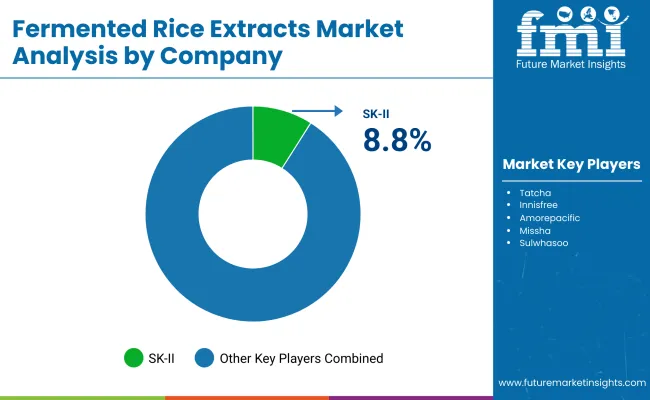
| Company | Global Value Share 2025 |
|---|---|
| SK-II | 8.8% |
| Others | 91.2% |
The fermented rice extracts market is moderately fragmented, with global leaders, regional innovators, and niche-focused brands competing across different consumer segments. Among global players, SK-II holds a dominant position with a global value share of 8.8% in 2025, making it the single largest brand in this space. Its leadership is anchored in strong brand equity, premium positioning, and consistent claim substantiation around brightening and pigmentation correction. In 2024, SK-II was already leading with an estimated share of just under 9%, reflecting its long-standing influence in Asia and global prestige markets.
Mid-sized innovators such as Tatcha, Innisfree, Amorepacific, Missha, and Sulwhasoo are recognized as core participants, leveraging heritage-driven narratives and expanding retail footprints. Their strategies emphasize traditional-herbal positioning, digital-first retail adoption, and premium mass-market hybrids, making them highly competitive in both Asian and Western markets.
Niche specialists including The Face Shop, Cosrx, Nature Republic, and Shiseido are catering to targeted consumer groups by focusing on sensitive-skin, vegan-friendly, and clean-label formulations. These brands are creating differentiation through affordability, dermatologist-endorsed claims, and effective penetration into online beauty ecosystems.
Competitive differentiation is increasingly shifting toward innovation in claim authenticity, microbiome safety validation, and e-commerce-led engagement. Over the next decade, integrated strategies combining clinical efficacy, heritage storytelling, and digital consumer touchpoints are expected to shape leadership outcomes in the fermented rice extracts market.
Key Developments in Fermented Rice Extracts Market
| Item | Value |
|---|---|
| Market Size (2025) | USD 1,052.4 million |
| Market Size (2035) | USD 3,413.4 million |
| CAGR (2025-2035) | 12.50% |
| Growth (Absolute, 2025-2035) | USD 2,361.0 million |
| Function Segments | Brightening 54.5% (USD 572.7 million); Others 45.5% (USD 478.36 million) |
| Claim Segments | Traditional herbal 51.5% (USD 541.4 million); Others 48.5% (USD 510.25 million) |
| Extract Type Segments | Rice water ferment 48.5% (USD 509.1 million); Others 51.5% (USD 542.15 million) |
| Country Growth Benchmarks (CAGR 2025-2035) | India 23.1%; China 20.5%; Japan 16.6%; UK 13.3%; Germany 10.4%; USA 8.5% |
| United States Sales Outlook | USD 227.46 million (2025) → USD 689.58 million (2035), CAGR ~11.7% |
| Channels Covered | E-commerce, Asian beauty specialty retail, Pharmacies, Mass retail chains, Premium department stores, Spas & clinics |
| End-user Focus | Women, Men, Unisex, Sensitive skin |
| Regions Covered | North America, Europe, East Asia, South Asia & Pacific, Latin America, Middle East & Africa |
| Countries Covered | United States, China, Japan, India, United Kingdom, Germany, plus others across covered regions |
| Key Companies Profiled | SK-II, Tatcha, Innisfree, Amorepacific, Missha, Sulwhasoo, The Face Shop, Cosrx, Nature Republic, Shiseido |
| Competitive Landscape | SK-II 8.8% global share (2025); Others 91.2% |
| Additional Attributes | Dollar sales by function, claim, extract type; premium adoption in brightening; strong digital-first strategies; heritage positioning with clinical validation; sensitive-skin and fragrance-free preference shaping long-term growth |
The global fermented rice extracts market is estimated to be valued at USD 1,052.4 million in 2025.
The market size for the fermented rice extracts market is projected to reach USD 3,413.4 million by 2035.
The fermented rice extracts market is expected to grow at a CAGR of 12.5% between 2025 and 2035.
The key segments in the fermented rice extracts market are function (brightening, others), claim (traditional herbal, others), and extract type (rice water ferment, others).
In terms of function, the brightening segment is projected to command 54.5% share, valued at USD 572.7 million, in the fermented rice extracts market in 2025.






Full Research Suite comprises of:
Market outlook & trends analysis
Interviews & case studies
Strategic recommendations
Vendor profiles & capabilities analysis
5-year forecasts
8 regions and 60+ country-level data splits
Market segment data splits
12 months of continuous data updates
DELIVERED AS:
PDF EXCEL ONLINE
Fermented Coffee Market Size and Share Forecast Outlook 2025 to 2035
Fermented Botanicals for Anti-Aging Market Size and Share Forecast Outlook 2025 to 2035
Fermented Vitamins Market Analysis - Size and Share Forecast Outlook 2025 to 2035
Fermented Amino Acid Complex Market Size and Share Forecast Outlook 2025 to 2035
Fermented Beverages Market Size and Share Forecast Outlook 2025 to 2035
Fermented Pet Ingredient Market Size and Share Forecast Outlook 2025 to 2035
Fermented Food and Beverage Market Analysis - Size, Share, and Forecast Outlook 2025 to 2035
Fermented Face Mask Market Size and Share Forecast Outlook 2025 to 2035
Fermented Processed Food Market Size and Share Forecast Outlook 2025 to 2035
Fermented Dairy Products Market Analysis - Size, Share, & Forecast Outlook 2025 to 2035
Fermented Dairy Ingredient Market Analysis - Size, Share, & Forecast Outlook 2025 to 2035
Fermented Seaweed Market Analysis - Size, Share, and Forecast Outlook 2025 to 2035
Fermented Chymosin Market Analysis - Size, Share, & Forecast Outlook 2025 to 2035
Fermented Flavours Market Size, Growth, and Forecast for 2025 to 2035
Fermented Ingredient Market Size, Growth, and Forecast for 2025 to 2035
Fermented Feed Market Analysis by Product Type, Livestock and Fermentation Process Through 2035
Market Share Breakdown of Fermented Ingredients
Fermented Cucumber Market Trends - Growth & Consumer Demand 2025 to 2035
Fermented Protein Market Trends - Innovations & Growth 2025 to 2035
Fermented Sweeteners Market

Thank you!
You will receive an email from our Business Development Manager. Please be sure to check your SPAM/JUNK folder too.
Chat With
MaRIA